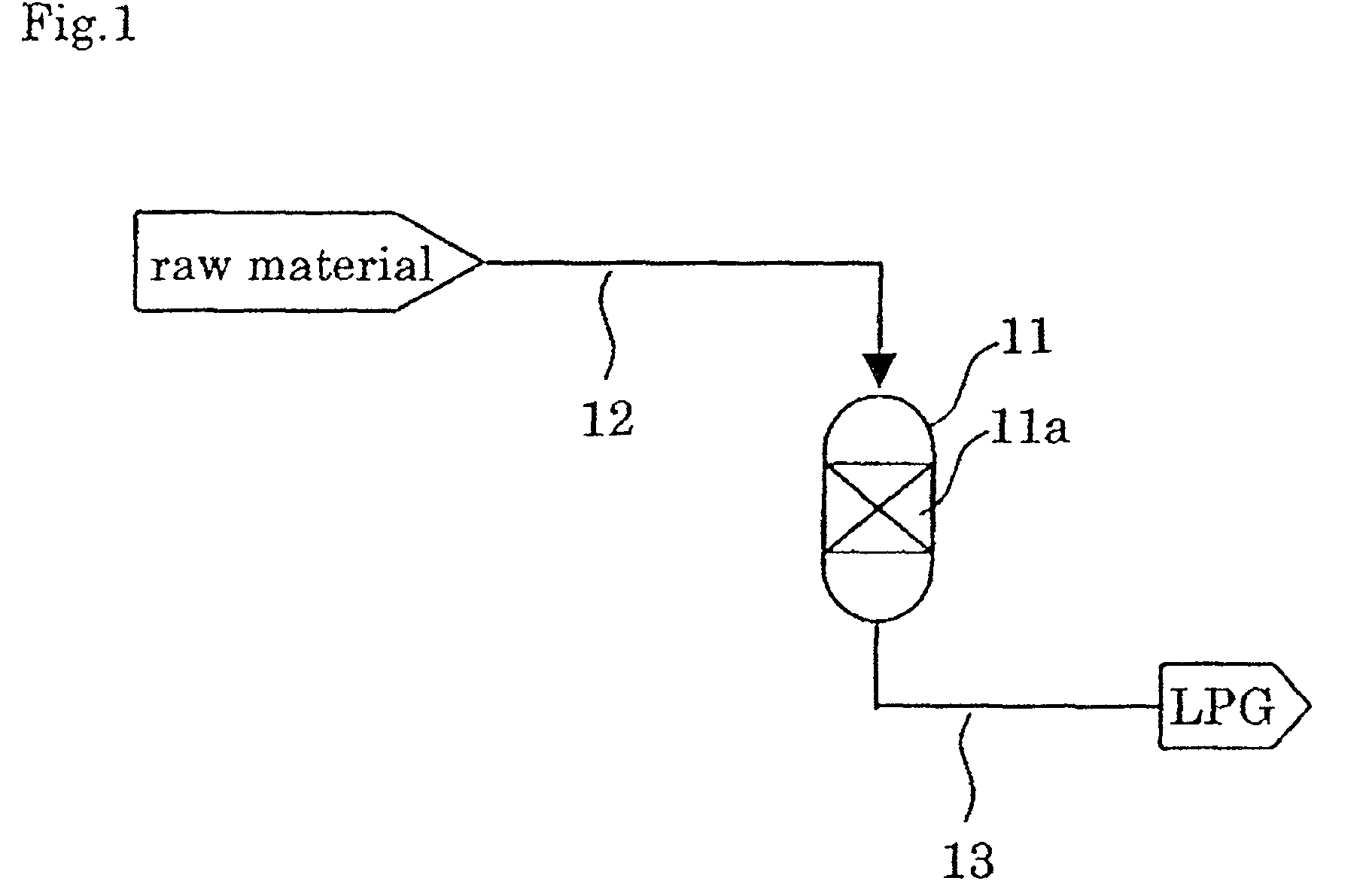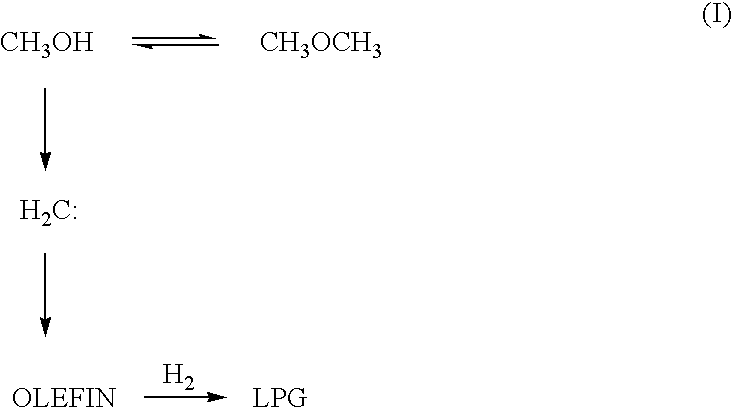Catalyst and process for producing liquefied petroleum gas
a technology of liquefied petroleum gas and catalyst, which is applied in the direction of hydrocarbon preparation catalysts, metal/metal-oxide/metal-hydroxide catalysts, physical/chemical process catalysts, etc., can solve the problems of insufficient activity of the process, insufficient high yield of hydrocarbons, and insufficient low carbon dioxide content of products obtained by the above-mentioned process, so as to prolong the catalyst life, stably produce, and reduce the deterioration
- Summary
- Abstract
- Description
- Claims
- Application Information
AI Technical Summary
Benefits of technology
Problems solved by technology
Method used
Image
Examples
example 1
[0136](Preparation of a Catalyst)
[0137]A mechanically powdered catalyst in which 0.5 wt % of Pd was supported on silica (Pd / SiO2; average particle size: 1 μm) was used as a Pd- and / or Pt-based catalyst component. The catalyst was prepared as follows.
[0138]The silica, which is a support for the Pd- and / or Pt-based catalyst component, was CARIACT G3 (trade name), produced by Fuji Silysia Chemical Ltd. The silica had a specific surface area of 820 m2 / g, as determined by a BET method with N2 as an adsorption gas, using ASAP2010 (Shimadzu Corporation).
[0139]First, the silica was pulverized to 20 to 40 mesh, sized and dried. And then, 8.8 mL of a 50 mg / mL aqueous solution of Pd(NO3)2(NH3)2 was added drop by drop to 20 g of the silica. After sufficiently impregnating the solution into pores, the silica was dried in a drying machine at 120° C. for 12 hours. The above process of impregnation and drying was repeated two more times.
[0140]Then, the silica impregnated with Pd was calcined at 450...
example 2
[0148](Preparation of a Catalyst)
[0149]A catalyst was prepared in the same way as Example 1, except that a proton-type USY zeolite with a SiO2 / Al2O3 ratio of 20 (USY(20)) was used as a USY-type zeolite.
[0150](Production of LPG)
[0151]Using the prepared catalyst, the LPG production reaction was carried out in the same way as Example 1.
[0152]Gas chromatographic analysis of the product indicated that, after three hours from the beginning of the reaction, a conversion of dimethyl ether was 100%, a conversion of dimethyl ether to carbon monoxide was 2.7%, a conversion of dimethyl ether to carbon dioxide was 0.0%, and a conversion of dimethyl ether to a hydrocarbon was 97.3%. The produced hydrocarbon gas contained propane and butane in 65.2% on the basis of carbon. A conversion of dimethyl ether to propane and butane was 63.4% on the basis of carbon.
[0153]The results are shown in Table 1.
example 3
[0154](Preparation of a Catalyst)
[0155]A catalyst was prepared in the same way as Example 1, except that a proton-type USY zeolite with a SiO2 / Al2O3 ratio of 30 (USY(30)) was used as a USY-type zeolite.
[0156](Production of LPG)
[0157]Using the prepared catalyst, the LPG production reaction was carried out in the same way as Example 1.
[0158]Gas chromatographic analysis of the product indicated that, after three hours from the beginning of the reaction, a conversion of dimethyl ether was 99.8%, a conversion of dimethyl ether to carbon monoxide was 2.7%, a conversion of dimethyl ether to carbon dioxide was 0.0%, and a conversion of dimethyl ether to a hydrocarbon was 97.1%. The produced hydrocarbon gas contained propane and butane in 64.3% on the basis of carbon. A conversion of dimethyl ether to propane and butane was 62.4% on the basis of carbon.
[0159]The results are shown in Table 1.
[0160]
TABLE 1Example 1Example 2Example 3CatalystPd / SiO2:USY(10) = 1:2Pd / SiO2:USY(20) = 1:2Pd / SiO2:USY(...
PUM
| Property | Measurement | Unit |
|---|---|---|
| specific surface area | aaaaa | aaaaa |
| temperature | aaaaa | aaaaa |
| temperature | aaaaa | aaaaa |
Abstract
Description
Claims
Application Information
 Login to View More
Login to View More - R&D
- Intellectual Property
- Life Sciences
- Materials
- Tech Scout
- Unparalleled Data Quality
- Higher Quality Content
- 60% Fewer Hallucinations
Browse by: Latest US Patents, China's latest patents, Technical Efficacy Thesaurus, Application Domain, Technology Topic, Popular Technical Reports.
© 2025 PatSnap. All rights reserved.Legal|Privacy policy|Modern Slavery Act Transparency Statement|Sitemap|About US| Contact US: help@patsnap.com


